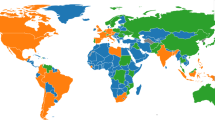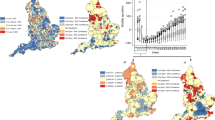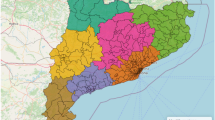Abstract
The method introduced by Knox for evaluation of space-time clustering has been applied to 872 cases of childhood (0-14 year old) leukaemia diagnosed in Greece over the 10 year period 1980-89. Greek towns are characterised by substantial population mixing due to internal migration, whereas there is relative isolation in mountainous rural areas. Predetermined space (5 km) and time (1 year) limits were used on the basis of previous reports in order to define the clustering cell. There is highly significant evidence for clustering of childhood leukaemia in Greece as a whole, the observed number of pairs that are close in both spaces and time exceeding the expected number by 5.2% (P = 0.004). The excess is particularly evident for leukaemia cases in 0 to 4-year-old children, among whom the observed number of pairs that are close in both space and time exceeded the expected number by 9.4% (P = 0.004). There is no evidence of space-time clustering for leukaemia cases older than 5 years. The overall pattern is descriptively similar in urban and semiurban areas and is especially marked for acute lymphoblastic leukaemia at the childhood peak ages (2-4 years) with an excess of 19% (P = 0.0006). In the rural population there is evidence for clustering of cases belonging to older and broader age groups, a phenomenon compatible with a delay in the development of herd immunity against putative infectious aetiological agents. The findings of the present study provide support for the hypothesis that a substantial proportion of cases of childhood leukaemia may arise as a rare sequel to exposure to an agent or agents, most probably viral in nature.
This is a preview of subscription content, access via your institution
Access options
Subscribe to this journal
Receive 24 print issues and online access
$259.00 per year
only $10.79 per issue
Buy this article
- Purchase on Springer Link
- Instant access to full article PDF
Prices may be subject to local taxes which are calculated during checkout
Similar content being viewed by others
Author information
Authors and Affiliations
Rights and permissions
About this article
Cite this article
Petridou, E., Revinthi, K., Alexander, F. et al. Space-time clustering of childhood leukaemia in Greece: evidence supporting a viral aetiology. Br J Cancer 73, 1278–1283 (1996). https://doi.org/10.1038/bjc.1996.245
Issue Date:
DOI: https://doi.org/10.1038/bjc.1996.245
This article is cited by
-
Space–time clustering of childhood cancers: a systematic review and pooled analysis
European Journal of Epidemiology (2019)
-
Spatial uncertainty in cluster detection
Spatial Information Research (2016)
-
Seroprevalence of Human Herpes Simplex, Hepatitis B and Epstein-Barr Viruses in Children with Acute Lymphoblastic Leukemia in Southern Iran
Pathology & Oncology Research (2010)
-
Does population mixing measure infectious exposure in children at the community level?
European Journal of Epidemiology (2008)
-
Infection, immune responses and the aetiology of childhood leukaemia
Nature Reviews Cancer (2006)



